Effective Tour Operation Management: Strategies and Analysis
VerifiedAdded on 2024/07/29
|21
|4085
|204
Report
AI Summary
This report provides a comprehensive overview of tour operation management within the travel and tourism sector, focusing on strategic analysis and recent developments. It begins with a leaflet discussing technological advancements, changing tourist preferences, and dynamic packaging. The report then delves into the stages of developing holiday packages, including research, planning, contracting, cost estimation, brochure creation, execution, and post-management, using the example of a student trip from London to Brussels and Bruges. Various contracting methods, such as sales-only, ad-hoc, and fixed contracts, are evaluated for different tour operator types. Furthermore, the report reviews brochures from Virgin Holidays and Thomas Cook, examining content, images, and colors, and explores alternative distribution methods like applications and social media. The analysis also covers cost estimation for tour packages, considering expenses like room costs, local guide fees, and transportation, to determine selling prices and profit margins. The report concludes by emphasizing the importance of adapting to modern marketing activities and leveraging technology to enhance tour operation management.
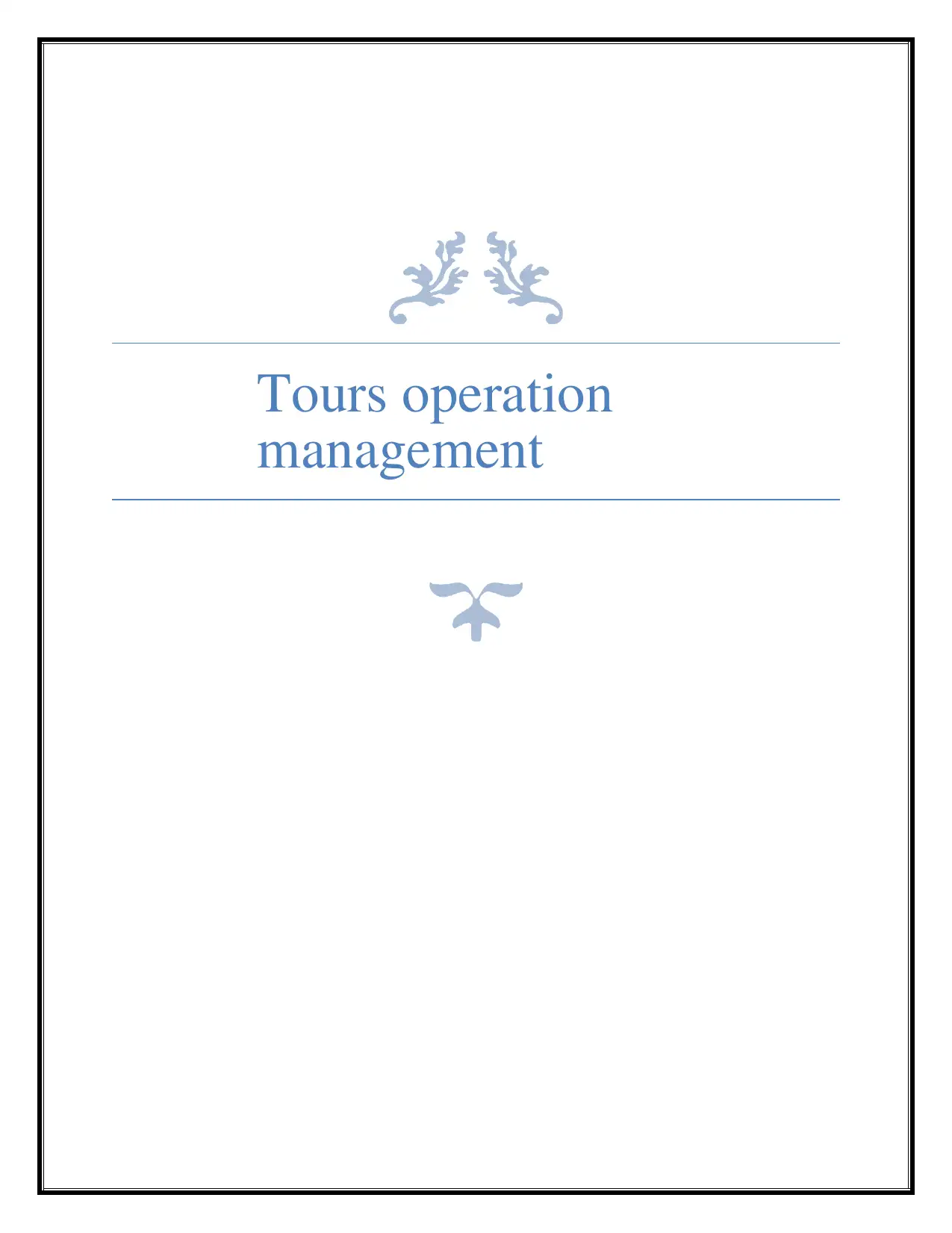
Paraphrase This Document
Need a fresh take? Get an instant paraphrase of this document with our AI Paraphraser
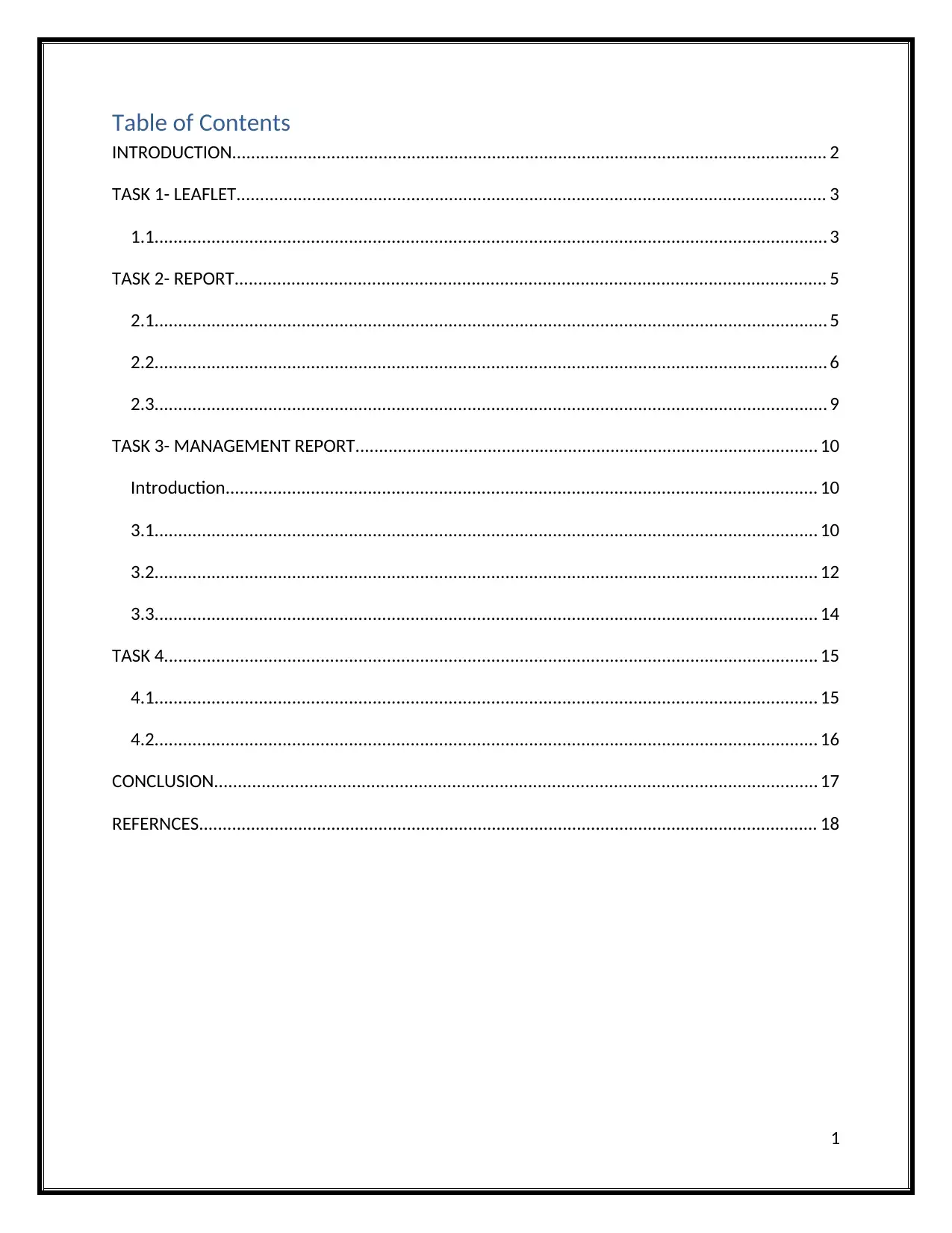
Table of Contents
INTRODUCTION.............................................................................................................................. 2
TASK 1- LEAFLET............................................................................................................................. 3
1.1.............................................................................................................................................. 3
TASK 2- REPORT............................................................................................................................. 5
2.1.............................................................................................................................................. 5
2.2.............................................................................................................................................. 6
2.3.............................................................................................................................................. 9
TASK 3- MANAGEMENT REPORT.................................................................................................. 10
Introduction............................................................................................................................. 10
3.1............................................................................................................................................ 10
3.2............................................................................................................................................ 12
3.3............................................................................................................................................ 14
TASK 4.......................................................................................................................................... 15
4.1............................................................................................................................................ 15
4.2............................................................................................................................................ 16
CONCLUSION............................................................................................................................... 17
REFERNCES................................................................................................................................... 18
1
INTRODUCTION.............................................................................................................................. 2
TASK 1- LEAFLET............................................................................................................................. 3
1.1.............................................................................................................................................. 3
TASK 2- REPORT............................................................................................................................. 5
2.1.............................................................................................................................................. 5
2.2.............................................................................................................................................. 6
2.3.............................................................................................................................................. 9
TASK 3- MANAGEMENT REPORT.................................................................................................. 10
Introduction............................................................................................................................. 10
3.1............................................................................................................................................ 10
3.2............................................................................................................................................ 12
3.3............................................................................................................................................ 14
TASK 4.......................................................................................................................................... 15
4.1............................................................................................................................................ 15
4.2............................................................................................................................................ 16
CONCLUSION............................................................................................................................... 17
REFERNCES................................................................................................................................... 18
1
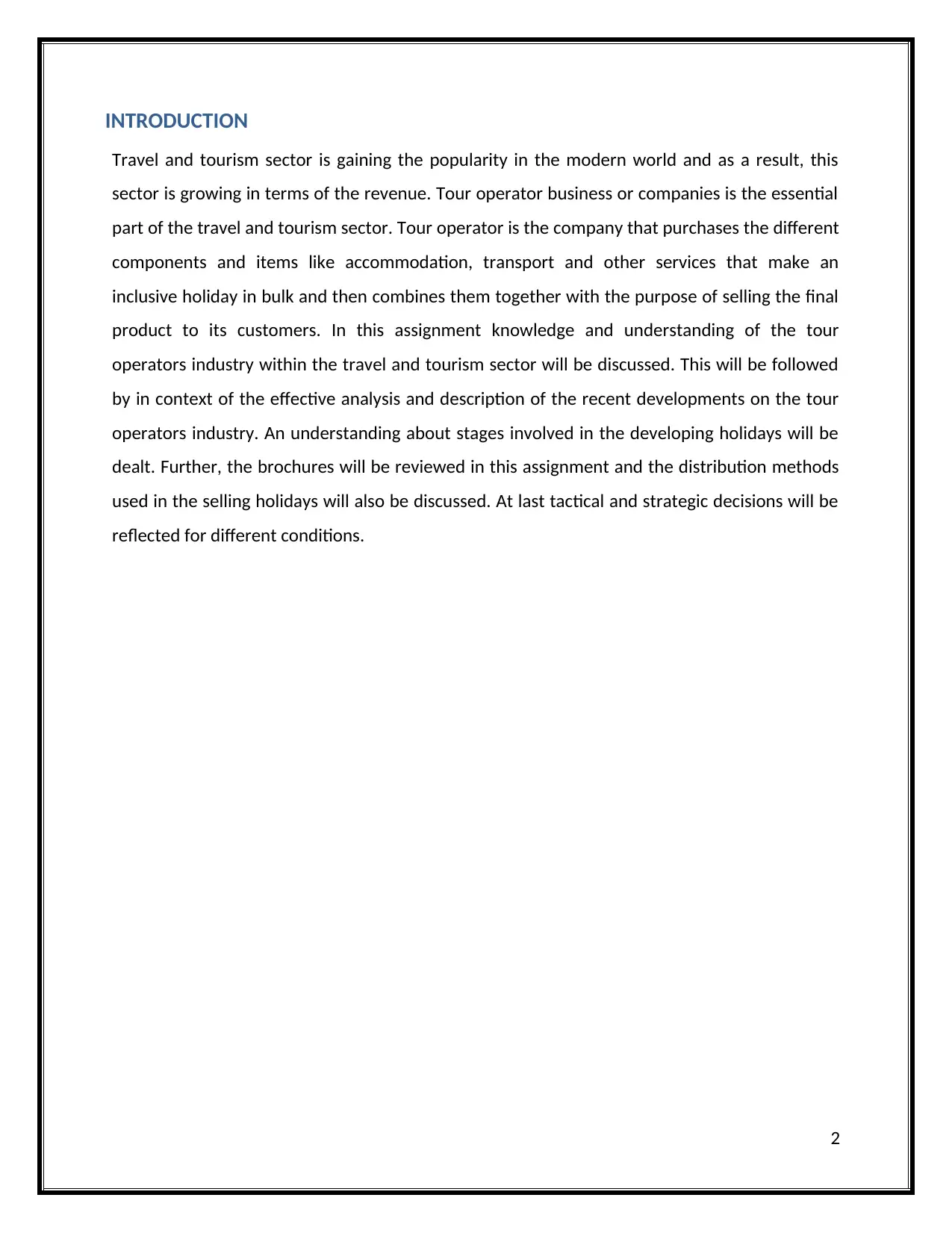
INTRODUCTION
Travel and tourism sector is gaining the popularity in the modern world and as a result, this
sector is growing in terms of the revenue. Tour operator business or companies is the essential
part of the travel and tourism sector. Tour operator is the company that purchases the different
components and items like accommodation, transport and other services that make an
inclusive holiday in bulk and then combines them together with the purpose of selling the final
product to its customers. In this assignment knowledge and understanding of the tour
operators industry within the travel and tourism sector will be discussed. This will be followed
by in context of the effective analysis and description of the recent developments on the tour
operators industry. An understanding about stages involved in the developing holidays will be
dealt. Further, the brochures will be reviewed in this assignment and the distribution methods
used in the selling holidays will also be discussed. At last tactical and strategic decisions will be
reflected for different conditions.
2
Travel and tourism sector is gaining the popularity in the modern world and as a result, this
sector is growing in terms of the revenue. Tour operator business or companies is the essential
part of the travel and tourism sector. Tour operator is the company that purchases the different
components and items like accommodation, transport and other services that make an
inclusive holiday in bulk and then combines them together with the purpose of selling the final
product to its customers. In this assignment knowledge and understanding of the tour
operators industry within the travel and tourism sector will be discussed. This will be followed
by in context of the effective analysis and description of the recent developments on the tour
operators industry. An understanding about stages involved in the developing holidays will be
dealt. Further, the brochures will be reviewed in this assignment and the distribution methods
used in the selling holidays will also be discussed. At last tactical and strategic decisions will be
reflected for different conditions.
2
⊘ This is a preview!⊘
Do you want full access?
Subscribe today to unlock all pages.

Trusted by 1+ million students worldwide
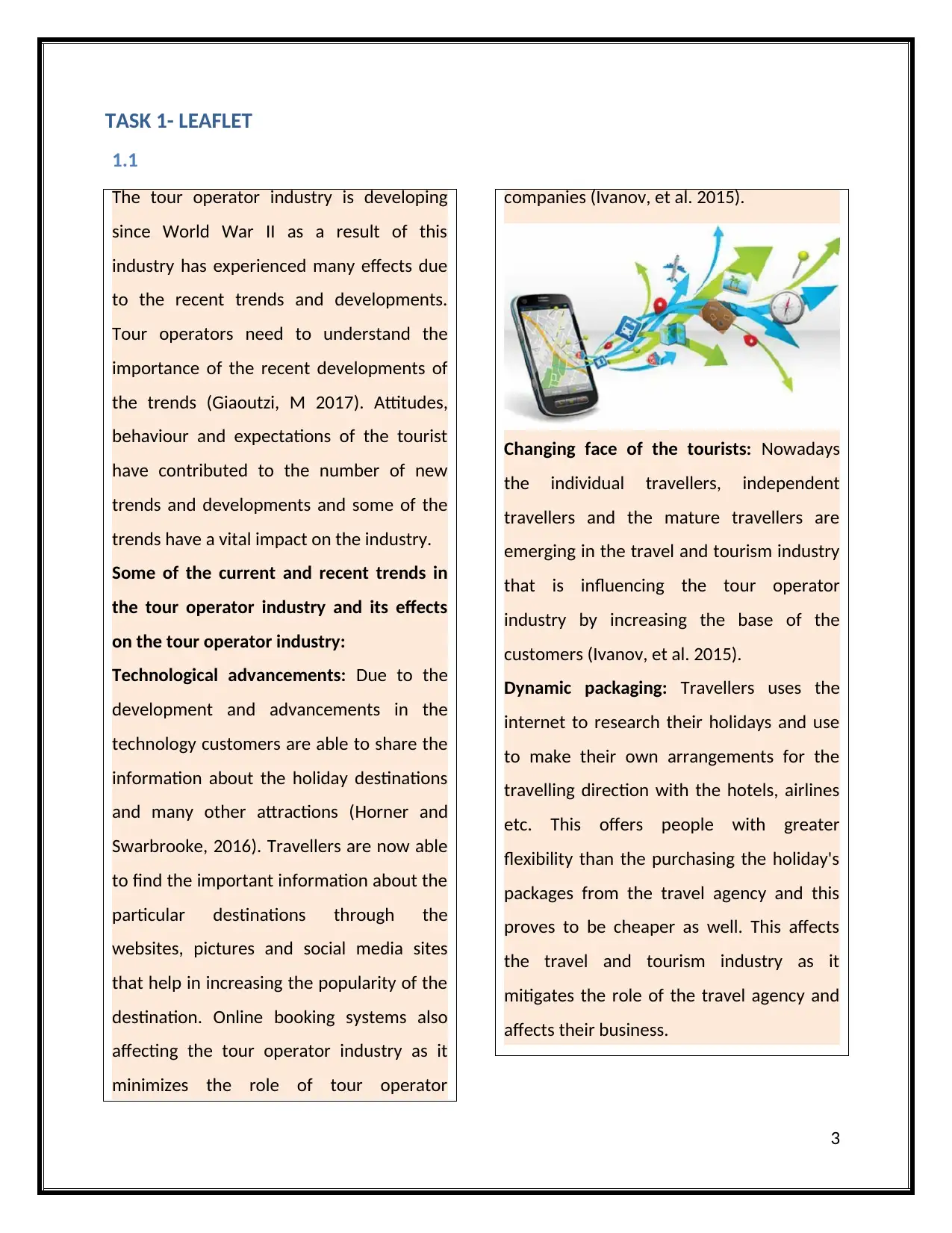
TASK 1- LEAFLET
1.1
The tour operator industry is developing
since World War II as a result of this
industry has experienced many effects due
to the recent trends and developments.
Tour operators need to understand the
importance of the recent developments of
the trends (Giaoutzi, M 2017). Attitudes,
behaviour and expectations of the tourist
have contributed to the number of new
trends and developments and some of the
trends have a vital impact on the industry.
Some of the current and recent trends in
the tour operator industry and its effects
on the tour operator industry:
Technological advancements: Due to the
development and advancements in the
technology customers are able to share the
information about the holiday destinations
and many other attractions (Horner and
Swarbrooke, 2016). Travellers are now able
to find the important information about the
particular destinations through the
websites, pictures and social media sites
that help in increasing the popularity of the
destination. Online booking systems also
affecting the tour operator industry as it
minimizes the role of tour operator
companies (Ivanov, et al. 2015).
Changing face of the tourists: Nowadays
the individual travellers, independent
travellers and the mature travellers are
emerging in the travel and tourism industry
that is influencing the tour operator
industry by increasing the base of the
customers (Ivanov, et al. 2015).
Dynamic packaging: Travellers uses the
internet to research their holidays and use
to make their own arrangements for the
travelling direction with the hotels, airlines
etc. This offers people with greater
flexibility than the purchasing the holiday's
packages from the travel agency and this
proves to be cheaper as well. This affects
the travel and tourism industry as it
mitigates the role of the travel agency and
affects their business.
3
1.1
The tour operator industry is developing
since World War II as a result of this
industry has experienced many effects due
to the recent trends and developments.
Tour operators need to understand the
importance of the recent developments of
the trends (Giaoutzi, M 2017). Attitudes,
behaviour and expectations of the tourist
have contributed to the number of new
trends and developments and some of the
trends have a vital impact on the industry.
Some of the current and recent trends in
the tour operator industry and its effects
on the tour operator industry:
Technological advancements: Due to the
development and advancements in the
technology customers are able to share the
information about the holiday destinations
and many other attractions (Horner and
Swarbrooke, 2016). Travellers are now able
to find the important information about the
particular destinations through the
websites, pictures and social media sites
that help in increasing the popularity of the
destination. Online booking systems also
affecting the tour operator industry as it
minimizes the role of tour operator
companies (Ivanov, et al. 2015).
Changing face of the tourists: Nowadays
the individual travellers, independent
travellers and the mature travellers are
emerging in the travel and tourism industry
that is influencing the tour operator
industry by increasing the base of the
customers (Ivanov, et al. 2015).
Dynamic packaging: Travellers uses the
internet to research their holidays and use
to make their own arrangements for the
travelling direction with the hotels, airlines
etc. This offers people with greater
flexibility than the purchasing the holiday's
packages from the travel agency and this
proves to be cheaper as well. This affects
the travel and tourism industry as it
mitigates the role of the travel agency and
affects their business.
3
Paraphrase This Document
Need a fresh take? Get an instant paraphrase of this document with our AI Paraphraser
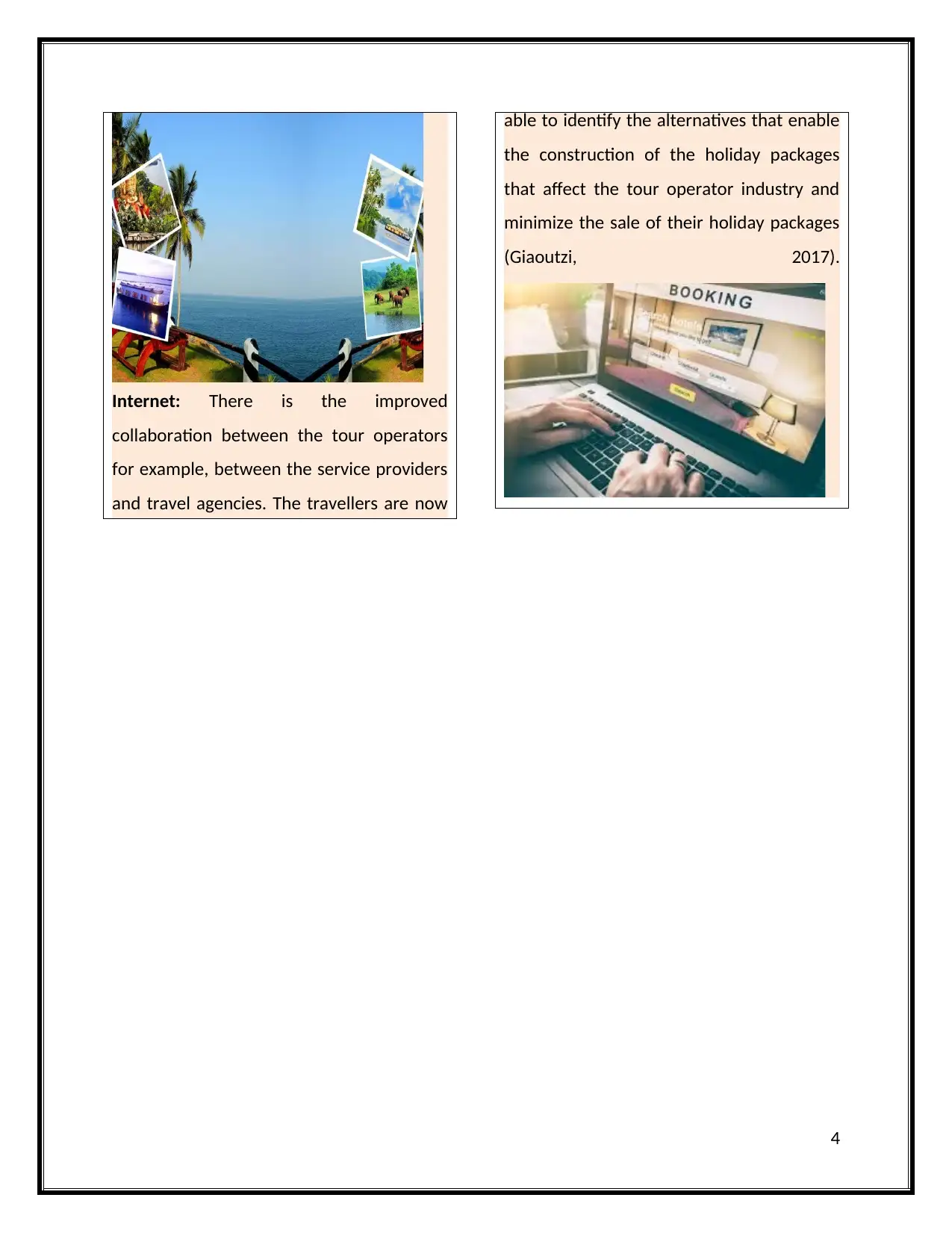
Internet: There is the improved
collaboration between the tour operators
for example, between the service providers
and travel agencies. The travellers are now
able to identify the alternatives that enable
the construction of the holiday packages
that affect the tour operator industry and
minimize the sale of their holiday packages
(Giaoutzi, 2017).
4
collaboration between the tour operators
for example, between the service providers
and travel agencies. The travellers are now
able to identify the alternatives that enable
the construction of the holiday packages
that affect the tour operator industry and
minimize the sale of their holiday packages
(Giaoutzi, 2017).
4
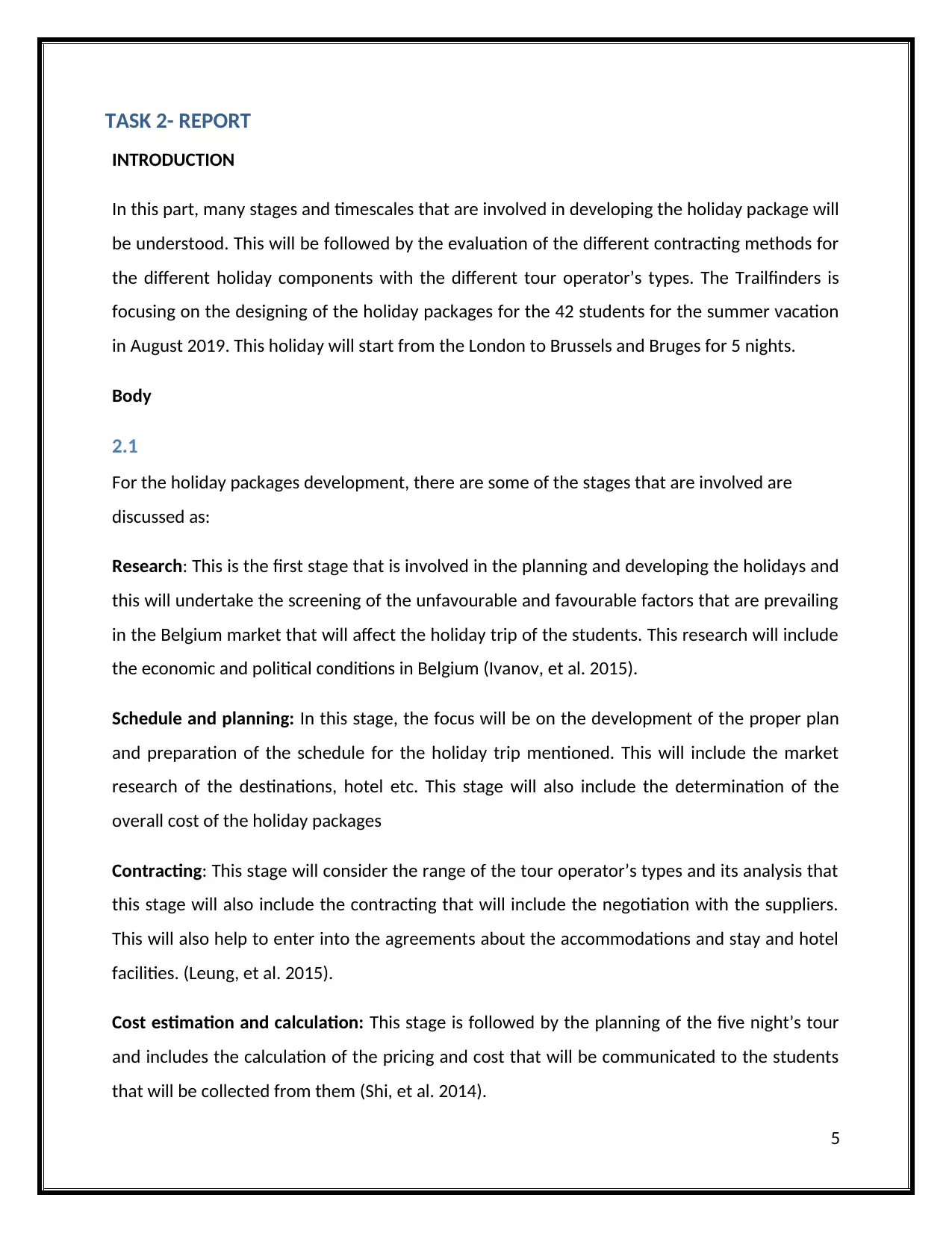
TASK 2- REPORT
INTRODUCTION
In this part, many stages and timescales that are involved in developing the holiday package will
be understood. This will be followed by the evaluation of the different contracting methods for
the different holiday components with the different tour operator’s types. The Trailfinders is
focusing on the designing of the holiday packages for the 42 students for the summer vacation
in August 2019. This holiday will start from the London to Brussels and Bruges for 5 nights.
Body
2.1
For the holiday packages development, there are some of the stages that are involved are
discussed as:
Research: This is the first stage that is involved in the planning and developing the holidays and
this will undertake the screening of the unfavourable and favourable factors that are prevailing
in the Belgium market that will affect the holiday trip of the students. This research will include
the economic and political conditions in Belgium (Ivanov, et al. 2015).
Schedule and planning: In this stage, the focus will be on the development of the proper plan
and preparation of the schedule for the holiday trip mentioned. This will include the market
research of the destinations, hotel etc. This stage will also include the determination of the
overall cost of the holiday packages
Contracting: This stage will consider the range of the tour operator’s types and its analysis that
this stage will also include the contracting that will include the negotiation with the suppliers.
This will also help to enter into the agreements about the accommodations and stay and hotel
facilities. (Leung, et al. 2015).
Cost estimation and calculation: This stage is followed by the planning of the five night’s tour
and includes the calculation of the pricing and cost that will be communicated to the students
that will be collected from them (Shi, et al. 2014).
5
INTRODUCTION
In this part, many stages and timescales that are involved in developing the holiday package will
be understood. This will be followed by the evaluation of the different contracting methods for
the different holiday components with the different tour operator’s types. The Trailfinders is
focusing on the designing of the holiday packages for the 42 students for the summer vacation
in August 2019. This holiday will start from the London to Brussels and Bruges for 5 nights.
Body
2.1
For the holiday packages development, there are some of the stages that are involved are
discussed as:
Research: This is the first stage that is involved in the planning and developing the holidays and
this will undertake the screening of the unfavourable and favourable factors that are prevailing
in the Belgium market that will affect the holiday trip of the students. This research will include
the economic and political conditions in Belgium (Ivanov, et al. 2015).
Schedule and planning: In this stage, the focus will be on the development of the proper plan
and preparation of the schedule for the holiday trip mentioned. This will include the market
research of the destinations, hotel etc. This stage will also include the determination of the
overall cost of the holiday packages
Contracting: This stage will consider the range of the tour operator’s types and its analysis that
this stage will also include the contracting that will include the negotiation with the suppliers.
This will also help to enter into the agreements about the accommodations and stay and hotel
facilities. (Leung, et al. 2015).
Cost estimation and calculation: This stage is followed by the planning of the five night’s tour
and includes the calculation of the pricing and cost that will be communicated to the students
that will be collected from them (Shi, et al. 2014).
5
⊘ This is a preview!⊘
Do you want full access?
Subscribe today to unlock all pages.

Trusted by 1+ million students worldwide
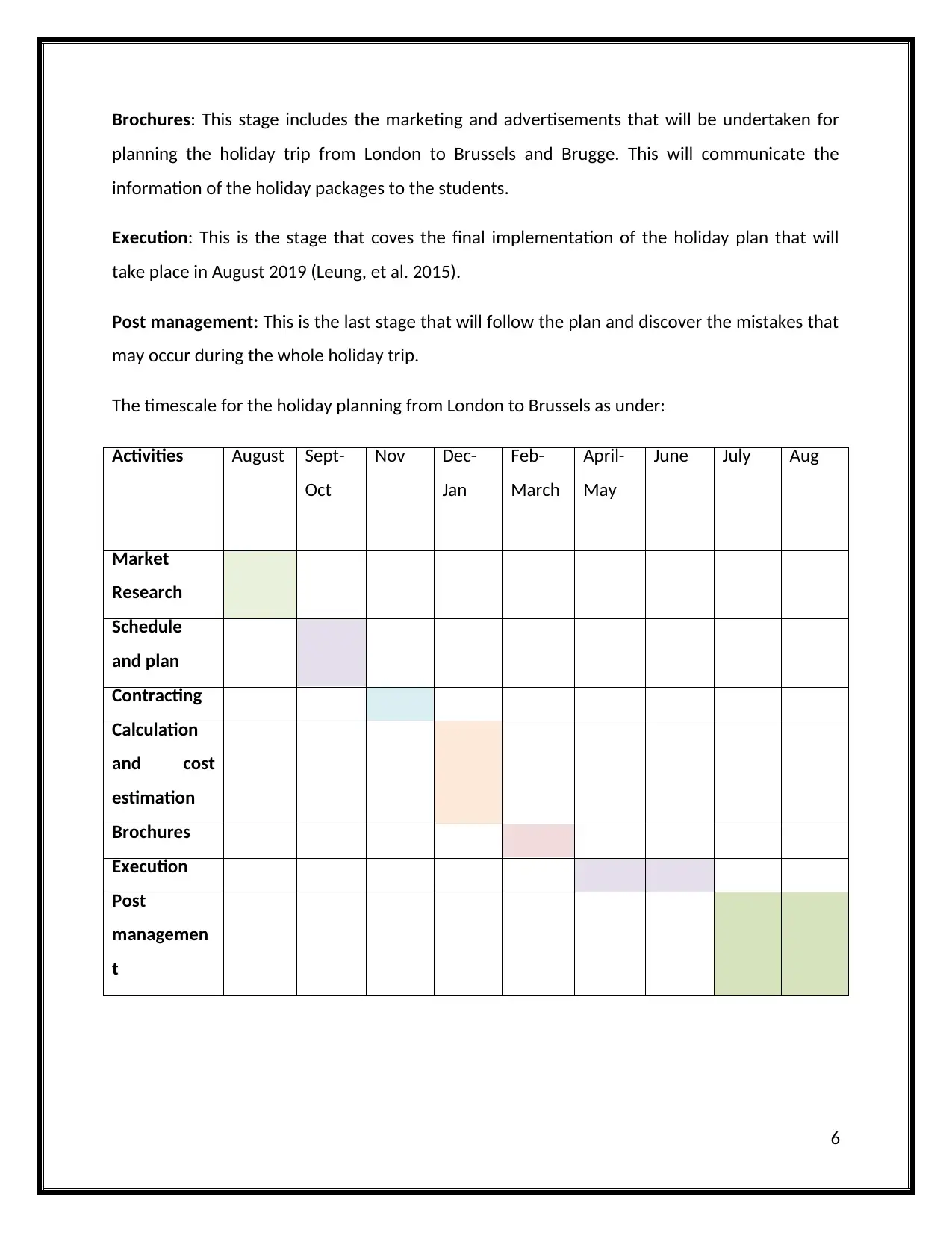
Brochures: This stage includes the marketing and advertisements that will be undertaken for
planning the holiday trip from London to Brussels and Brugge. This will communicate the
information of the holiday packages to the students.
Execution: This is the stage that coves the final implementation of the holiday plan that will
take place in August 2019 (Leung, et al. 2015).
Post management: This is the last stage that will follow the plan and discover the mistakes that
may occur during the whole holiday trip.
The timescale for the holiday planning from London to Brussels as under:
Activities August Sept-
Oct
Nov Dec-
Jan
Feb-
March
April-
May
June July Aug
Market
Research
Schedule
and plan
Contracting
Calculation
and cost
estimation
Brochures
Execution
Post
managemen
t
6
planning the holiday trip from London to Brussels and Brugge. This will communicate the
information of the holiday packages to the students.
Execution: This is the stage that coves the final implementation of the holiday plan that will
take place in August 2019 (Leung, et al. 2015).
Post management: This is the last stage that will follow the plan and discover the mistakes that
may occur during the whole holiday trip.
The timescale for the holiday planning from London to Brussels as under:
Activities August Sept-
Oct
Nov Dec-
Jan
Feb-
March
April-
May
June July Aug
Market
Research
Schedule
and plan
Contracting
Calculation
and cost
estimation
Brochures
Execution
Post
managemen
t
6
Paraphrase This Document
Need a fresh take? Get an instant paraphrase of this document with our AI Paraphraser
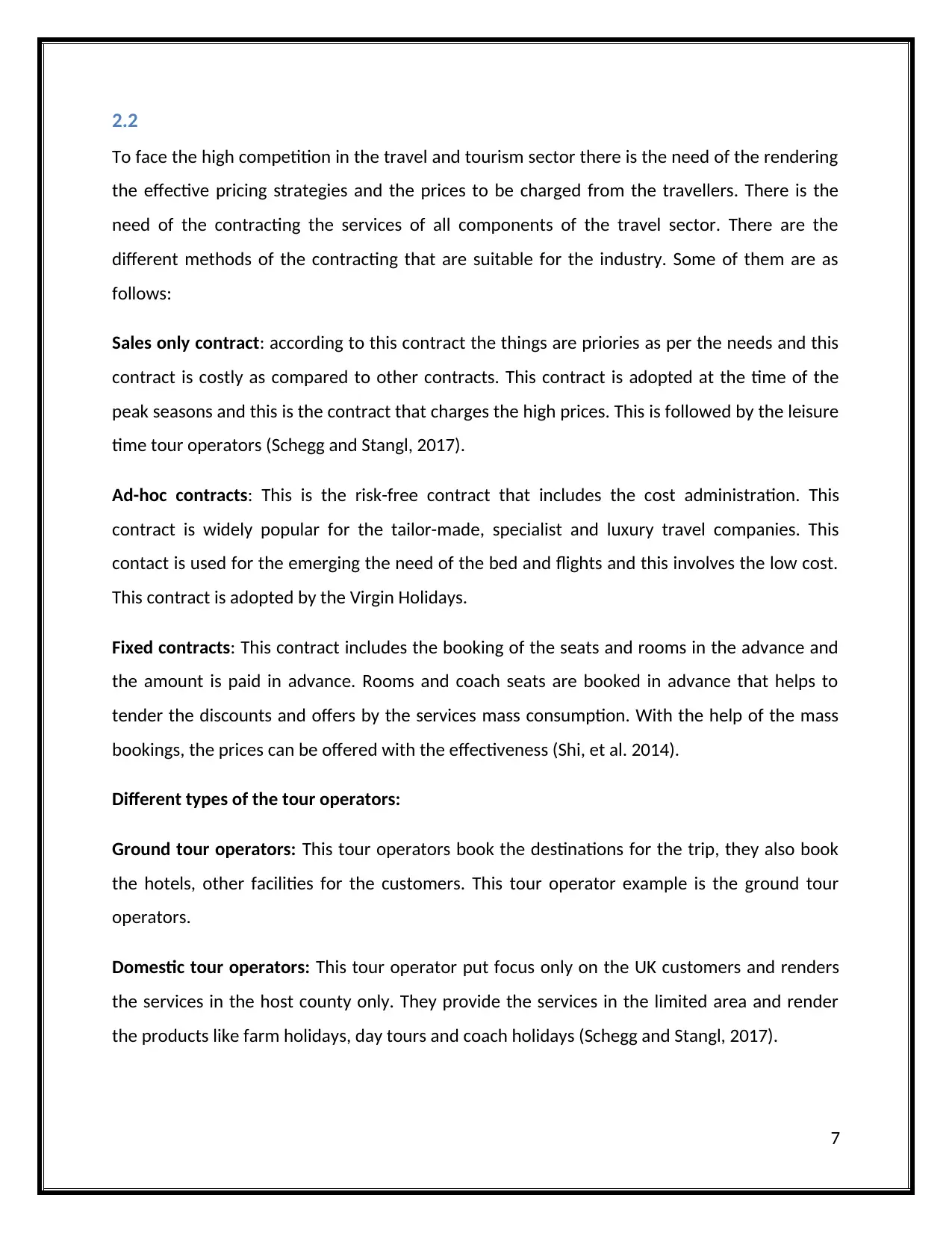
2.2
To face the high competition in the travel and tourism sector there is the need of the rendering
the effective pricing strategies and the prices to be charged from the travellers. There is the
need of the contracting the services of all components of the travel sector. There are the
different methods of the contracting that are suitable for the industry. Some of them are as
follows:
Sales only contract: according to this contract the things are priories as per the needs and this
contract is costly as compared to other contracts. This contract is adopted at the time of the
peak seasons and this is the contract that charges the high prices. This is followed by the leisure
time tour operators (Schegg and Stangl, 2017).
Ad-hoc contracts: This is the risk-free contract that includes the cost administration. This
contract is widely popular for the tailor-made, specialist and luxury travel companies. This
contact is used for the emerging the need of the bed and flights and this involves the low cost.
This contract is adopted by the Virgin Holidays.
Fixed contracts: This contract includes the booking of the seats and rooms in the advance and
the amount is paid in advance. Rooms and coach seats are booked in advance that helps to
tender the discounts and offers by the services mass consumption. With the help of the mass
bookings, the prices can be offered with the effectiveness (Shi, et al. 2014).
Different types of the tour operators:
Ground tour operators: This tour operators book the destinations for the trip, they also book
the hotels, other facilities for the customers. This tour operator example is the ground tour
operators.
Domestic tour operators: This tour operator put focus only on the UK customers and renders
the services in the host county only. They provide the services in the limited area and render
the products like farm holidays, day tours and coach holidays (Schegg and Stangl, 2017).
7
To face the high competition in the travel and tourism sector there is the need of the rendering
the effective pricing strategies and the prices to be charged from the travellers. There is the
need of the contracting the services of all components of the travel sector. There are the
different methods of the contracting that are suitable for the industry. Some of them are as
follows:
Sales only contract: according to this contract the things are priories as per the needs and this
contract is costly as compared to other contracts. This contract is adopted at the time of the
peak seasons and this is the contract that charges the high prices. This is followed by the leisure
time tour operators (Schegg and Stangl, 2017).
Ad-hoc contracts: This is the risk-free contract that includes the cost administration. This
contract is widely popular for the tailor-made, specialist and luxury travel companies. This
contact is used for the emerging the need of the bed and flights and this involves the low cost.
This contract is adopted by the Virgin Holidays.
Fixed contracts: This contract includes the booking of the seats and rooms in the advance and
the amount is paid in advance. Rooms and coach seats are booked in advance that helps to
tender the discounts and offers by the services mass consumption. With the help of the mass
bookings, the prices can be offered with the effectiveness (Shi, et al. 2014).
Different types of the tour operators:
Ground tour operators: This tour operators book the destinations for the trip, they also book
the hotels, other facilities for the customers. This tour operator example is the ground tour
operators.
Domestic tour operators: This tour operator put focus only on the UK customers and renders
the services in the host county only. They provide the services in the limited area and render
the products like farm holidays, day tours and coach holidays (Schegg and Stangl, 2017).
7
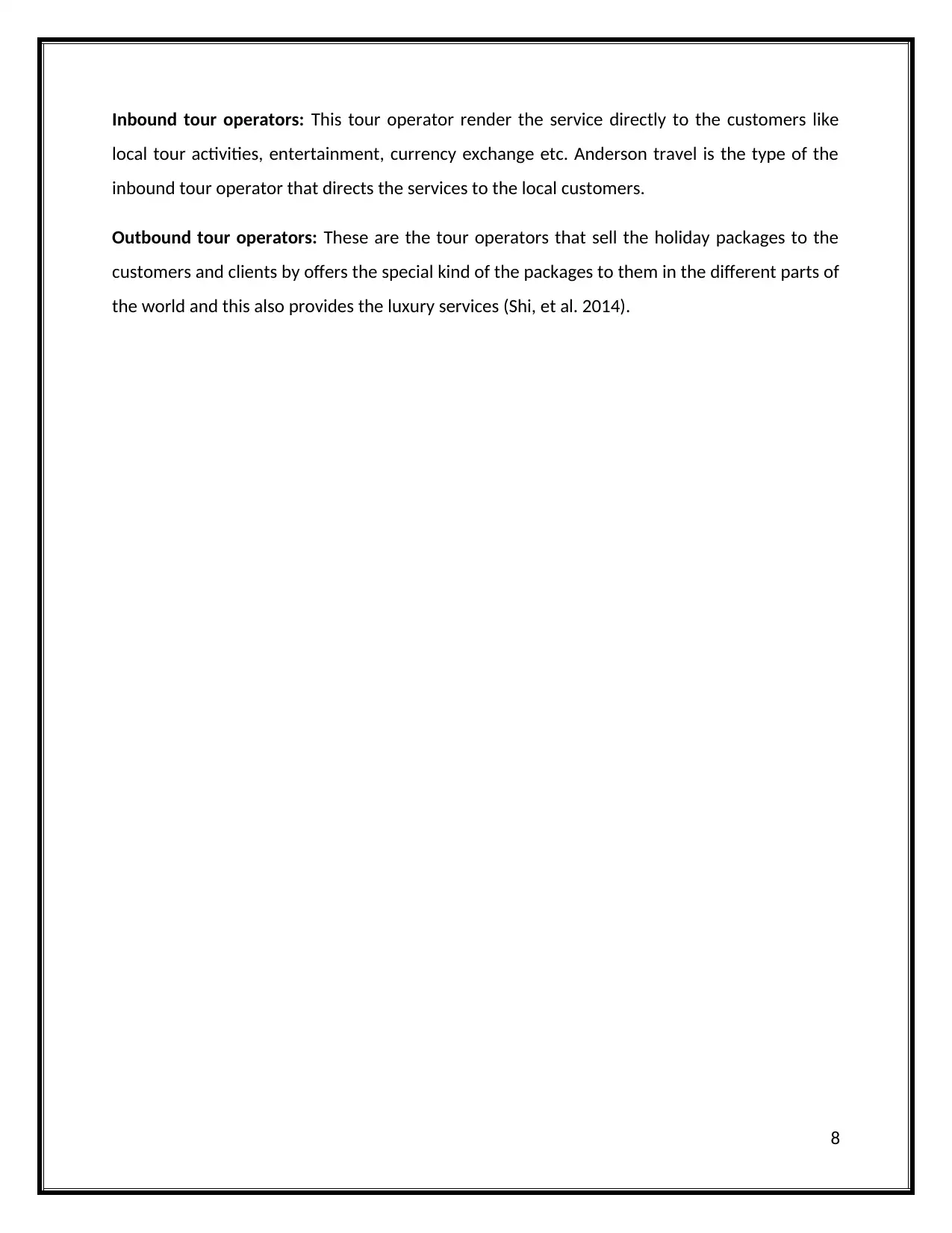
Inbound tour operators: This tour operator render the service directly to the customers like
local tour activities, entertainment, currency exchange etc. Anderson travel is the type of the
inbound tour operator that directs the services to the local customers.
Outbound tour operators: These are the tour operators that sell the holiday packages to the
customers and clients by offers the special kind of the packages to them in the different parts of
the world and this also provides the luxury services (Shi, et al. 2014).
8
local tour activities, entertainment, currency exchange etc. Anderson travel is the type of the
inbound tour operator that directs the services to the local customers.
Outbound tour operators: These are the tour operators that sell the holiday packages to the
customers and clients by offers the special kind of the packages to them in the different parts of
the world and this also provides the luxury services (Shi, et al. 2014).
8
⊘ This is a preview!⊘
Do you want full access?
Subscribe today to unlock all pages.

Trusted by 1+ million students worldwide
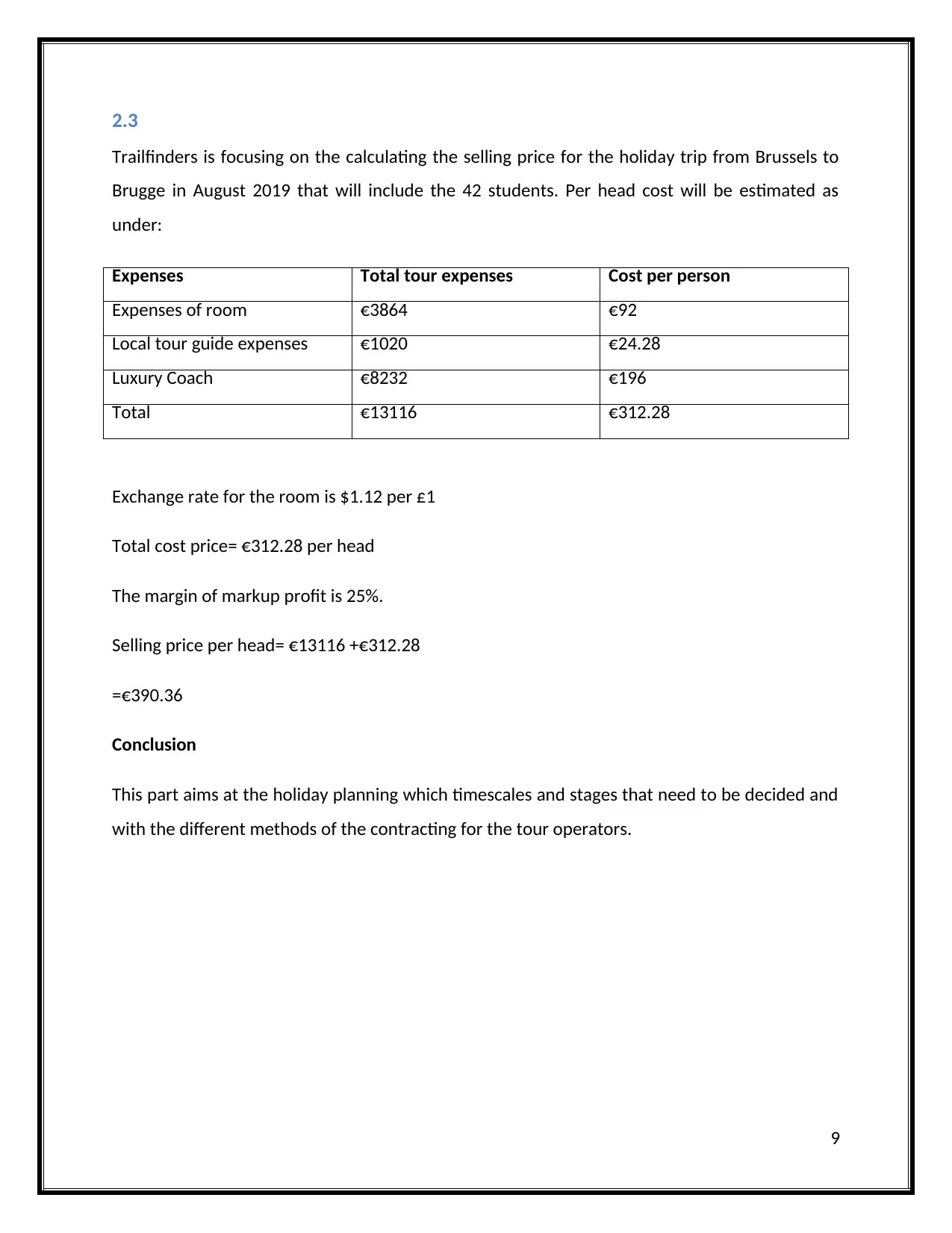
2.3
Trailfinders is focusing on the calculating the selling price for the holiday trip from Brussels to
Brugge in August 2019 that will include the 42 students. Per head cost will be estimated as
under:
Expenses Total tour expenses Cost per person
Expenses of room €3864 €92
Local tour guide expenses €1020 €24.28
Luxury Coach €8232 €196
Total €13116 €312.28
Exchange rate for the room is $1.12 per £1
Total cost price= €312.28 per head
The margin of markup profit is 25%.
Selling price per head= €13116 +€312.28
=€390.36
Conclusion
This part aims at the holiday planning which timescales and stages that need to be decided and
with the different methods of the contracting for the tour operators.
9
Trailfinders is focusing on the calculating the selling price for the holiday trip from Brussels to
Brugge in August 2019 that will include the 42 students. Per head cost will be estimated as
under:
Expenses Total tour expenses Cost per person
Expenses of room €3864 €92
Local tour guide expenses €1020 €24.28
Luxury Coach €8232 €196
Total €13116 €312.28
Exchange rate for the room is $1.12 per £1
Total cost price= €312.28 per head
The margin of markup profit is 25%.
Selling price per head= €13116 +€312.28
=€390.36
Conclusion
This part aims at the holiday planning which timescales and stages that need to be decided and
with the different methods of the contracting for the tour operators.
9
Paraphrase This Document
Need a fresh take? Get an instant paraphrase of this document with our AI Paraphraser
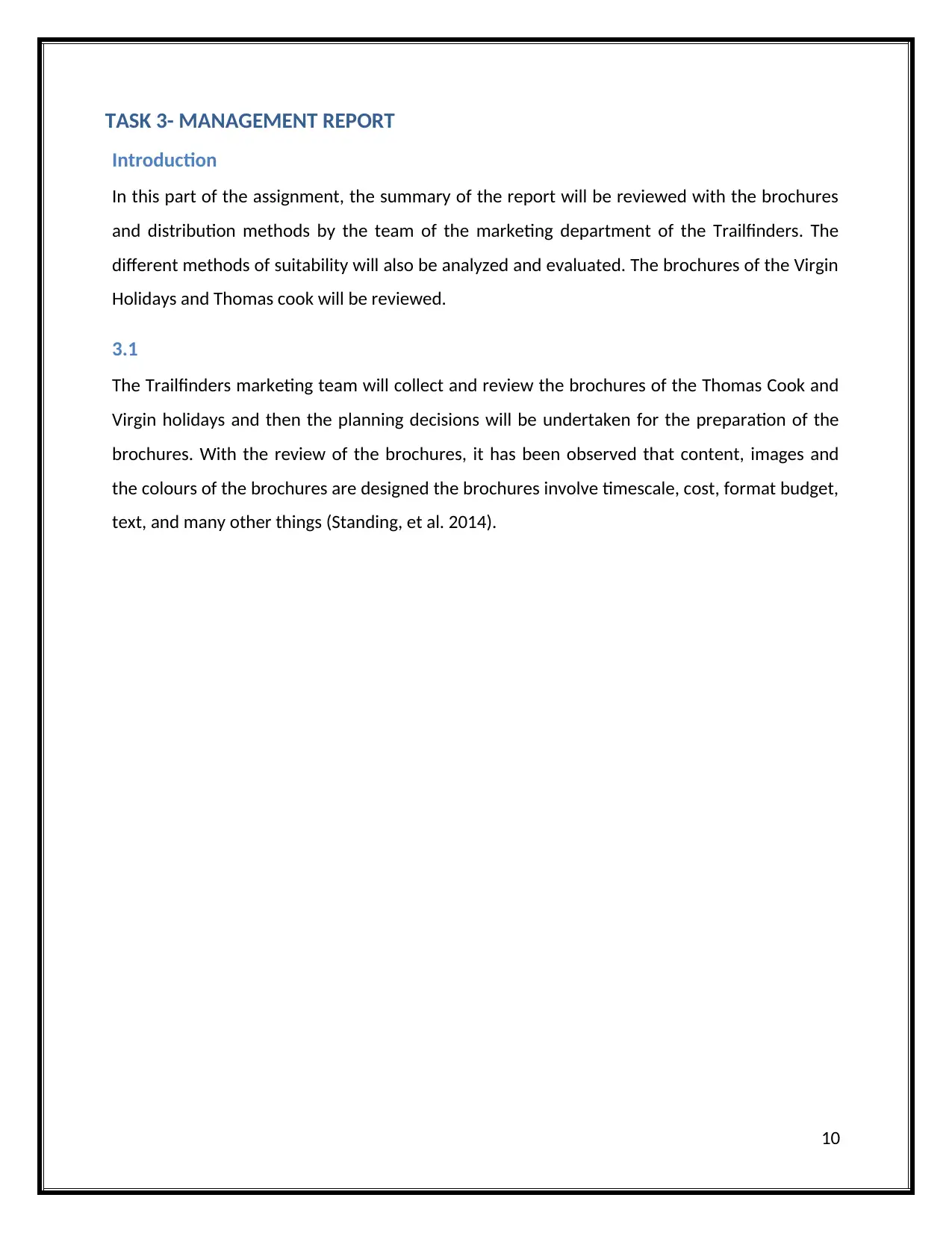
TASK 3- MANAGEMENT REPORT
Introduction
In this part of the assignment, the summary of the report will be reviewed with the brochures
and distribution methods by the team of the marketing department of the Trailfinders. The
different methods of suitability will also be analyzed and evaluated. The brochures of the Virgin
Holidays and Thomas cook will be reviewed.
3.1
The Trailfinders marketing team will collect and review the brochures of the Thomas Cook and
Virgin holidays and then the planning decisions will be undertaken for the preparation of the
brochures. With the review of the brochures, it has been observed that content, images and
the colours of the brochures are designed the brochures involve timescale, cost, format budget,
text, and many other things (Standing, et al. 2014).
10
Introduction
In this part of the assignment, the summary of the report will be reviewed with the brochures
and distribution methods by the team of the marketing department of the Trailfinders. The
different methods of suitability will also be analyzed and evaluated. The brochures of the Virgin
Holidays and Thomas cook will be reviewed.
3.1
The Trailfinders marketing team will collect and review the brochures of the Thomas Cook and
Virgin holidays and then the planning decisions will be undertaken for the preparation of the
brochures. With the review of the brochures, it has been observed that content, images and
the colours of the brochures are designed the brochures involve timescale, cost, format budget,
text, and many other things (Standing, et al. 2014).
10
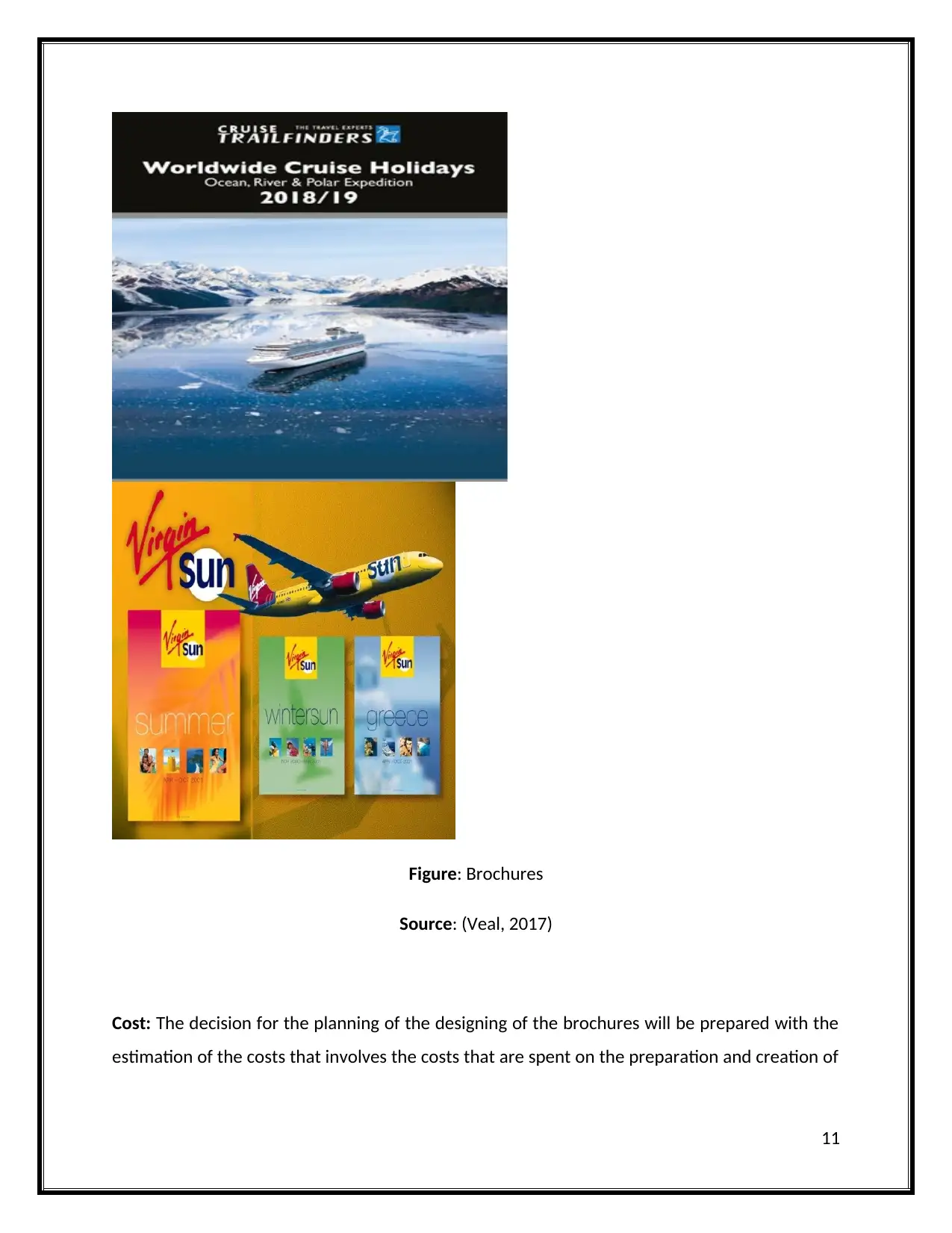
Figure: Brochures
Source: (Veal, 2017)
Cost: The decision for the planning of the designing of the brochures will be prepared with the
estimation of the costs that involves the costs that are spent on the preparation and creation of
11
Source: (Veal, 2017)
Cost: The decision for the planning of the designing of the brochures will be prepared with the
estimation of the costs that involves the costs that are spent on the preparation and creation of
11
⊘ This is a preview!⊘
Do you want full access?
Subscribe today to unlock all pages.

Trusted by 1+ million students worldwide
1 out of 21
Related Documents
Your All-in-One AI-Powered Toolkit for Academic Success.
+13062052269
info@desklib.com
Available 24*7 on WhatsApp / Email
![[object Object]](/_next/static/media/star-bottom.7253800d.svg)
Unlock your academic potential
Copyright © 2020–2025 A2Z Services. All Rights Reserved. Developed and managed by ZUCOL.





